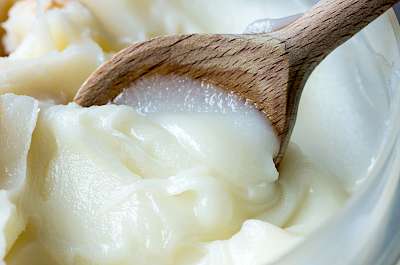Lard: Calories and Nutrition Analyse
How many calories in lard?

Nutrition Facts
LardServing size:
tablespoon of lard (12 g) change
5g10g15g20g30g40g50g60g80g100g120g140g160g180g200g220g250g300g350g400g450g500g600g700g800g900g1000g
1oz2oz3oz4oz5oz6oz7oz8oz10oz12oz15oz20oz25oz30oz35oz40oz50oz
Amount Per Serving:
100g of lard contain about 898 calories (kcal).
Calories per:
ounce
| tablespoon
| teaspoon
| slice
| cup
| half cup
To give you an idea, a tablespoon of lard (12 g) contain about 108 calories.
This is about 5% of the daily caloric intake for an average adult with medium weight and activity level (assuming a 2000 kcal daily intake).
Scroll down for details and nutrition tables.
To visualize how much 108 kcal actually is, keep in mind that the calorie content of tablespoon of lard is similar to that of, for example:
- 2 apples
- 1 glass of Coca Cola (220 ml glass)
- 1 slice of cheese
- 1 slice of bread
- 0.5 glass of milk
- 5.5 cubes of sugar
Take a quick look at the tables below for detailed information about lard nutrition.
100g of Lard
Nutrition
- Calories898
- Carbs Total0 g
- Dietary fiber0 g
- Fat99.5 g
- Protein0.07 g
- Water0.25 g
Vitamins
- Vit A37 IU
- Vit B1 (Thiamine)0.004 mg
- Vit B2 (riboflavin)0.015 mg
- Vit B3 (Niacin)0.725 mg
- Vit B60.005 mg
Minerals
- Potassium15 mg
- Phosphorus11 mg
- Calcium1 mg
- Sodium27 mg
- Iron0.13 mg
- Zink11 mg
Unlocking the Nutritional Secrets of Lard: A Deep Dive into Its Health Benefits
When it comes to cooking fats, lard has been a staple in many cultures for centuries. Despite its fluctuating reputation, recent trends towards whole, unprocessed foods have brought lard back into the spotlight, highlighting its nutritional benefits. Let's delve into the fascinating world of lard nutrition, examining its calories, protein, fat, and carbs content, and why it might just deserve a place in your healthy diet.
Caloric Content: High Energy in Every Spoonful
Lard is known for its high caloric content, with a whopping 898 calories per 100 grams. This makes it an energy-dense food, ideal for those needing high-energy foods to support active lifestyles or specific dietary needs.
The Fat Profile: A Closer Look
With 99.5 grams of fat per 100 grams, lard is almost entirely made up of fats. However, it's the quality of these fats that's interesting. Lard contains a balanced mix of saturated, monounsaturated, and polyunsaturated fats, making it a versatile fat for cooking and baking. The presence of 97 mg of cholesterol per 100 grams also plays a crucial role in hormone production and cellular health, although moderation is key for those monitoring their cholesterol intake.
Protein in Lard: A Trace Amount
While not a significant source of protein, lard does contain about 0.07 grams of protein per 100 grams. Though minimal, it's a reminder of lard's animal origins and its trace contributions to nutritional intake.
Carbs in Lard: Virtually Non-Existent
For those following a low-carb or ketogenic diet, lard is an excellent choice. It contains zero carbohydrates, making it purely a source of fat and a minimal amount of protein. This absence of carbs also means no sugars or fibers, aligning well with these dietary preferences.
Vitamins and Minerals: Small but Mighty Contributions
Despite its reputation primarily as a fat source, lard offers small amounts of essential vitamins and minerals. It provides vitamin A (37 IU per 100 grams), crucial for vision and immune health, and trace amounts of B vitamins, particularly vitamin B3 (niacin), which supports metabolism and skin health. Minerals like zinc (11 mg per 100 grams), iron, and potassium are also present, contributing to overall dietary diversity.
Integrating Lard into a Healthy Diet
Given its nutritional profile, incorporating lard into a balanced diet can offer various benefits. Its high smoke point makes it ideal for frying and sautéing, while its flavor enhances pastries and meats. However, like all fats, moderation is key. Balancing lard with sources of unsaturated fats, fibers, proteins, and carbohydrates can create a well-rounded, nutritious diet.
In conclusion, lard's nutritional composition of fat, calories, and essential vitamins and minerals, coupled with its minimal protein and carb content, makes it a valuable addition to the kitchen. By understanding and respecting its place within a balanced diet, we can appreciate lard not just for its culinary qualities but for its nutritional benefits as well.
How many calories are there in 1, 2, 3, or 5 servings of lard?
- Tablespoon of lard (12g)108 kcal
- Teaspoon of lard (4g)36 kcal
- Slice of lard (18g)162 kcal
- Cup of lard (205g)1841 kcal
- Half cup of lard (102.5g)920 kcal
- Ounce (oz) of lard255 kcal
- Half of medium size servings of lard54 kcal
- Small size serving of lard (10g)86.4 kcal
- Big size lard (16g)140.4 kcal
- Two medium size servings of lard216 kcal
- Three medium size servings of lard324 kcal
- Four medium size servings of lard432 kcal
- Five medium size servings of lard540 kcal
Compare lard:
lard vs bacon, lard vs peanut butter, lard vs butter 60% fat, see all compares of lard.

Similar calories number have:
See also:
Read this:
- How many calories does condensed milk have?
- Calories in a half of cranberry salad
- Calories in whole cranberry salad
- Calories for one, two or more cranberry salad
- How many carbs (carbohydrates) in torte cake?
- How much fat in Cheetos corn snacks?
- How much protein in pupusa?
- What is weight of martini?
- Twizzlers calories per ounce (oz)
- Maitake mushrooms calories per serving size



Add comment